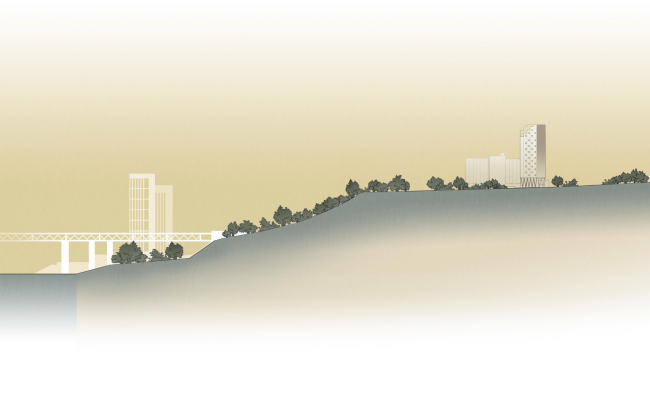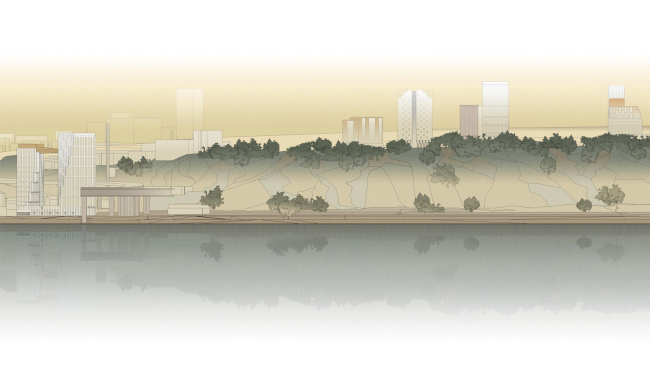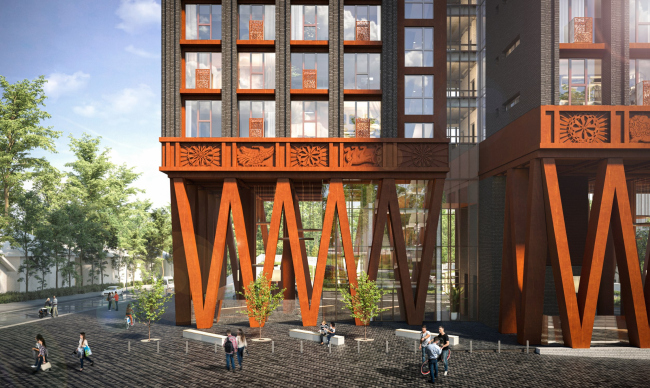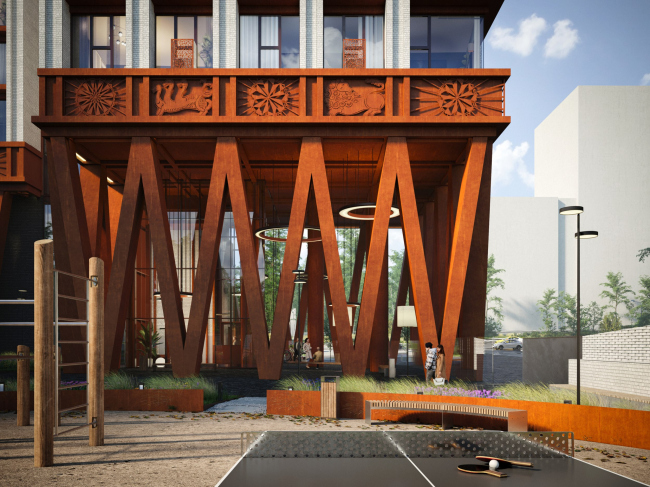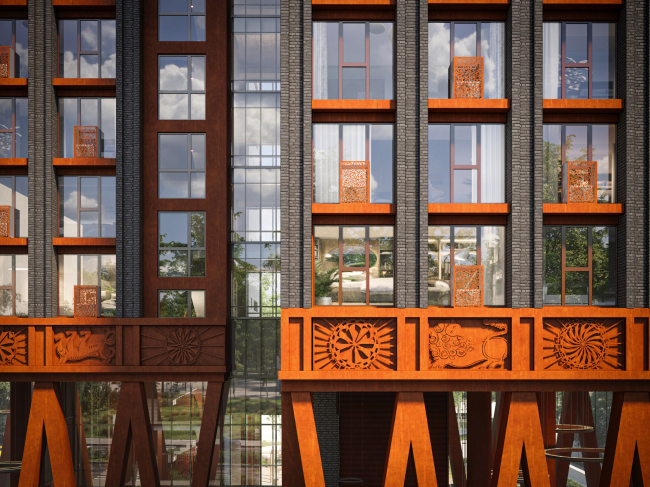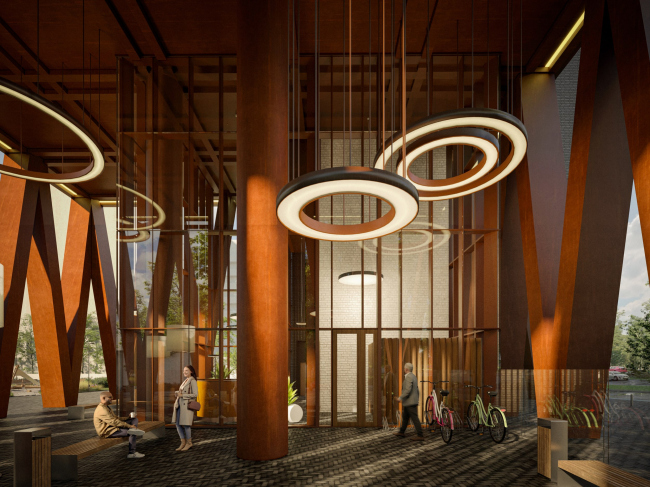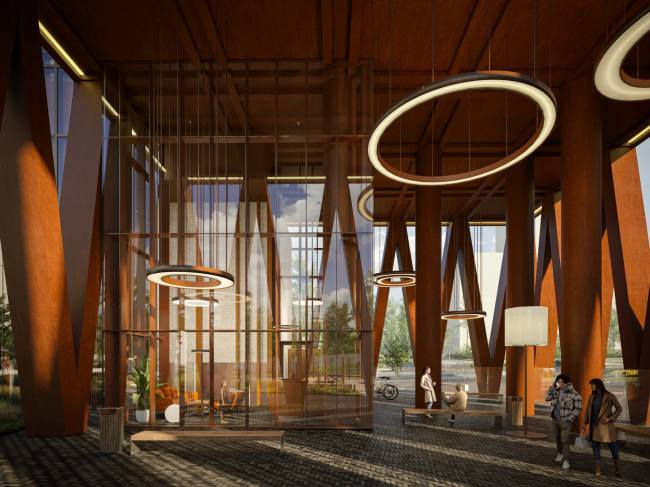|
Published on Archi.ru (https://archi.ru) |
|
| 20.05.2024 | |
|
The Fulcrum |
|
|
Julia Tarabarina |
|
| Architect: | |
| Rais Baishev | |
| Studio: | |
| Ostozhenka Bureau | |
|
Ostozhenka Architects have designed two astonishing towers practically on the edge of a slope above the Oka River in Nizhny Novgorod. These towers stand on 10-meter-tall weathered steel “legs”, with each floor offering panoramic views of the river and the city; all public spaces, including corridors, receive plenty of natural light. Here, we see a multitude of solutions that are unconventional for the residential routine of our day and age. Meanwhile, although these towers hark back to the typological explorations of the seventies, they are completely reinvented in a contemporary key. We admire Veren Group as the client – this is exactly how a “unique product” should be made – and we tell you exactly how our towers are arranged. Nizhny Novgorod is renowned for its high riverbanks – up to one hundred meters above the water level. One such bank is the right bank of the Oka before it flows into the Volga; in recent years, a lot of designing and building has been done here, both below and on the slope, with structures featuring large cantilevers as well as high-rises. The residential complex “Veren Place Odesskaya”, named after the street running near the edge of the slope, is one of these high-rises. Although not overly tall at 71 meters and 17 floors, it fits well with its growing surroundings. Residential Complex on Odesskaya Street in Nizhny Novgorod. On the right: the hero of our article; on the left: the Glorax Chernigovskaya Residential Complex, where the towers were also designed by Ostozhenka ArchitectsCopyright: © Ostozhenka ArchitectsResidential Complex on Odesskaya Street in Nizhny Novgorod. View from the Oka RiverCopyright: © Ostozhenka ArchitectsHowever, the project is interesting not due to the number of floors, but due to experiments in typology and volumetric-spatial construction, which is quite rare in the routine sphere of modern residential design. In this case, however, everything is the opposite: the building attracts attention with its uniqueness. First, its core is transparent – this is a hall with glass walls: the eastern one offers a panorama of the city, and the western one – of the river. The passenger elevator is also panoramic. Thus, you can admire the city and the expanse throughout the entire journey to your own door: a kind of emotional-spatial “attraction”. 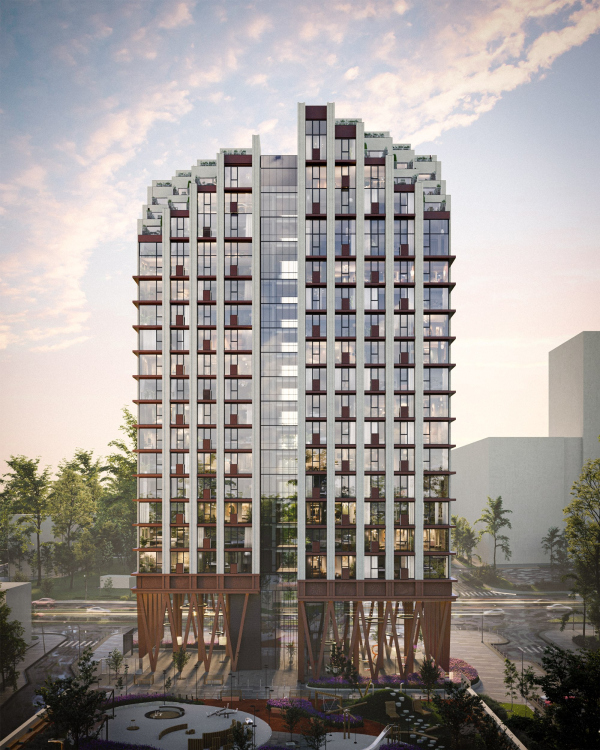 The west facade overlooking the river. Residential Complex on Odesskaya Street in Nizhny NovgorodCopyright: © Ostozhenka Architects Residential Complex on Odesskaya Street in Nizhny NovgorodCopyright: © Ostozhenka ArchitectsThe ends of the small corridors – the volumes are almost square, with few apartments per floor, from four to two – also end with glass walls. All public areas in the project receive natural light, creating a sort of “node” of transparency in the center of the composition. In the mutual arrangement of the volumes, one can see the principle of rotational symmetry – they are rotated 180°. But the principle is slightly adjusted here: in particular, the corner terraces are gathered in the western part, facing the river, panoramas, and sunsets – here, ordinary mirror symmetry comes into play, which does not make the building plans any less capacious and concise. 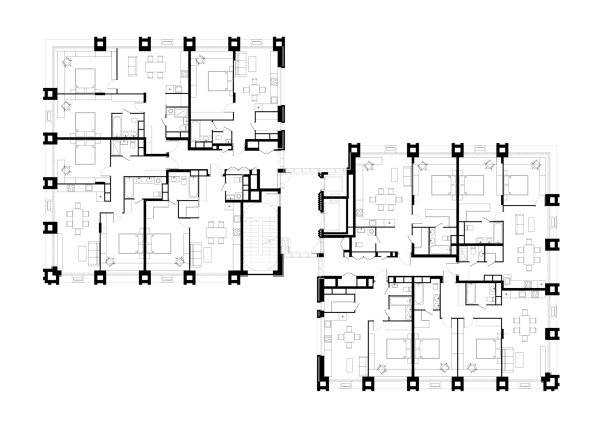 Plan of 2-7 floors. Residential Complex on Odesskaya Street in Nizhny NovgorodCopyright: © Ostozhenka Architects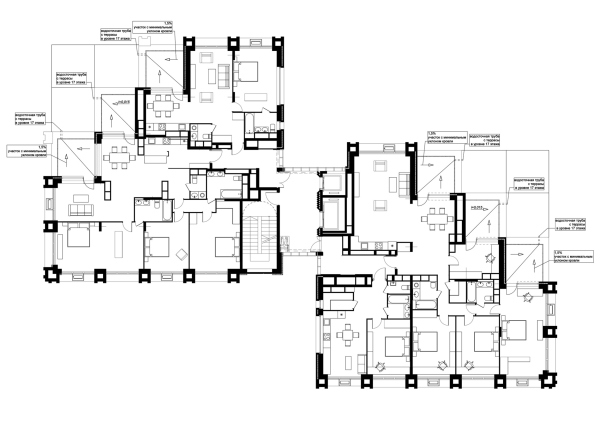 Plan of the 17 floor. Residential Complex on Odesskaya Street in Nizhny NovgorodCopyright: © Ostozhenka Architects Rais Baishev, Ostozhenka Bureau At one time, I was greatly impressed by Vladimir Plotkin’s “catamaran” house [the one in Zagorsky Lane], where two buildings are divided by an empty space but connected by communication links. I believe that there should be an empty space within a residential volume, a kind of “connecting pause” – this is the essence of the experiments we conduct when designing residential buildings. Then the building becomes light, if not airy, and gets plenty of light exposure. For example, in the “Watercolor” residential complex, rooms that usually lack natural light – corridors, bathrooms – are illuminated because their windows face small internal courtyards, which are embedded in the extended wings. Or in the newer Veren Village residential complex – also built for Veren Group, the same client as our project in Nizhny Novgorod – we managed to combine two stair-and-elevator units into one: they use a common elevator and receive sunlight through skylights. In “Odesskaya”, we have not two towers, but one building split in half. What divides it also connects it; this is the main, axial part, the compositional “spine”. Additionally, we almost entirely freed up the lower tier, creating a very unusual public space within it. Generally speaking, the solution for the lower tier is the most striking feature of the building’s architecture. It is not just set on legs – it is elevated very high, to the height of four floors, which is ten meters. Residential Complex on Odesskaya Street in Nizhny NovgorodCopyright: © Ostozhenka ArchitectsAs I was told, the solution was born when the client complained that the lower floors sold poorly – the architects responded by suggesting simply not to build them. Although the economic reason would be too simple – for example, in Moisei Ginzburg’s book “Housing”, this reason is listed among the arguments in favor of houses on stilts only as one of several. An equally important factor mentioned in the same book is ground-level ventilation. On the other hand, we all know all too well that the main advantage of houses on stilts is the effect of humans’ victory over gravity, the delight in realizing what seems impossible at a basic level of consciousness. So, the building stands on a light stroke of weathered steel supports, which simultaneously serve as columns and truss structures. Inside, the weight of the volumes is supported by four round-section supports and, of course, the communication node. 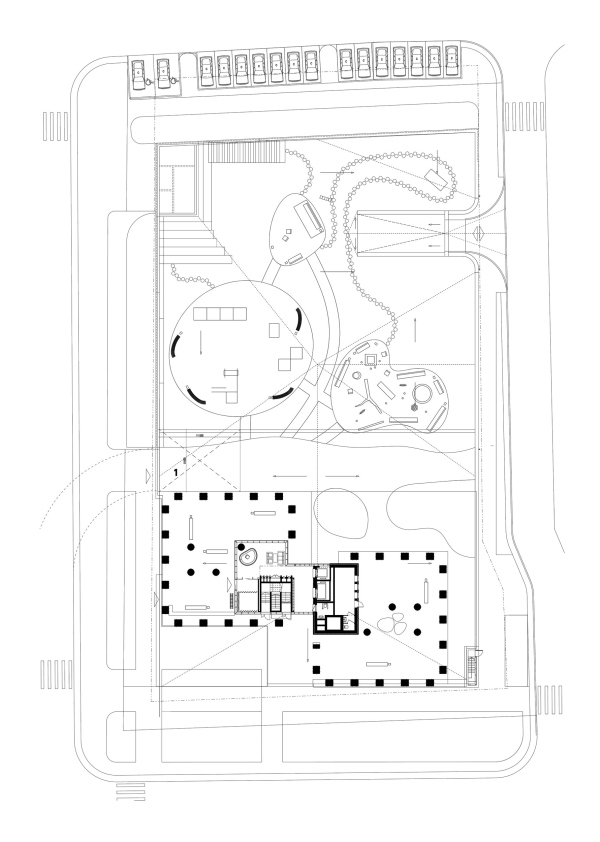 Plan of the 1 floor. Residential Complex on Odesskaya Street in Nizhny NovgorodCopyright: © Ostozhenka Architects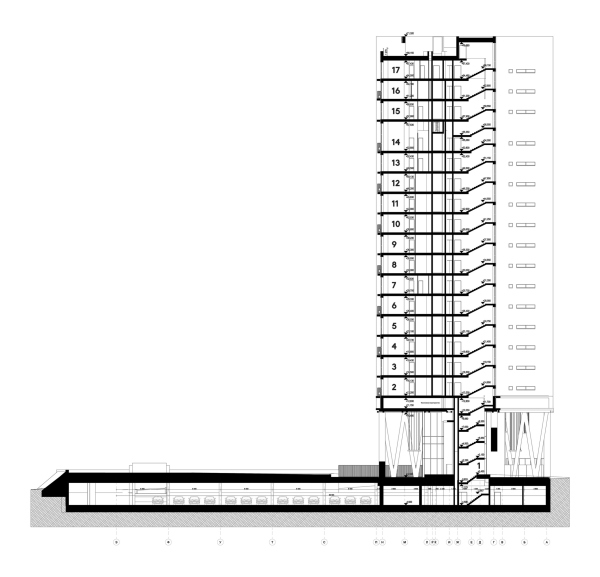 Section view 3-3. Residential Complex on Odesskaya Street in Nizhny NovgorodCopyright: © Ostozhenka ArchitectsThe resulting space is easiest to compare with modernist Corbusian houses: the principle is the same, but the columns are higher, corresponding to the capabilities of modern construction technologies. However, the architects also compare this space with lodges – the Loggia dei Lanzi in Florence, the Loggia del Capitanio in Vicenza – public spaces resembling giant and very voluminous porticos. Such spaces complemented the city squares of Italy during the Gothic and Renaissance periods; they served both for city gatherings and for the installation of sculptures. This is an important comparison since covered courtyards-loggias are popular in modern residential complexes both as an important addition to the public program of the building and as an atypical space with special emotional characteristics. In this case, the space occupies a large part of the area under the buildings and becomes not just an addition but a kind of mega-loggia that you will not see anywhere else.  Sophia Kaverina, Ostozhenka Bureau For me, the key aspects of this design are transparency and lightness. Such an elevated ground floor is almost never seen in residential buildings. From Odesskaya Street, you will be able to see the sunset over the Oka River through the building, and you can even feel the river air from the upper floors, from the city. At the same time, we remember that it can be very windy in Nizhny Novgorod, and the loggia under the building allows for a hierarchy of spaces, a gradual transition from open to protected – ultimately leading to one’s “fortress” apartment. At each stage of this transition, a person will be able to see both the city and the river. Residential Complex on Odesskaya Street in Nizhny Novgorod. The landscapingCopyright: © Ostozhenka ArchitectsThe brick facades continue the theme started by the paired composition of the volumes, and the color pattern is designed in a straightforward manner: white on the river side, black on the city side. The brick has already been chosen, and in both cases, it is covered with engobe and slightly glistens, reminiscent of modernist tiles but in a somewhat “rougher” picturesque version. However, there is not much brick, as there are not many walls here. Mostly, there are vertical pilaster-like elements that feel “Gothic”, quite voluminous and hollow inside, emerging on the facade as a wide groove where lighting is planned to be installed. 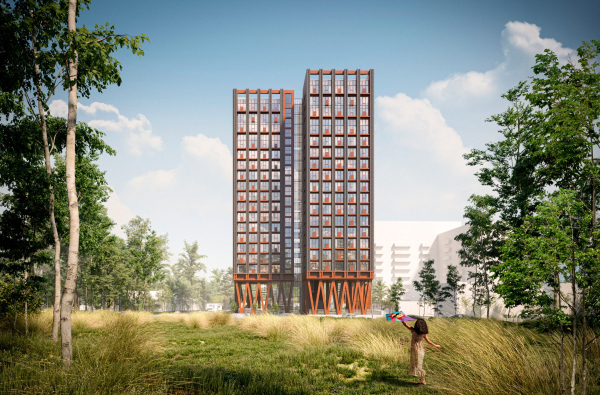 Residential Complex on Odesskaya Street in Nizhny NovgorodCopyright: © Ostozhenka Architects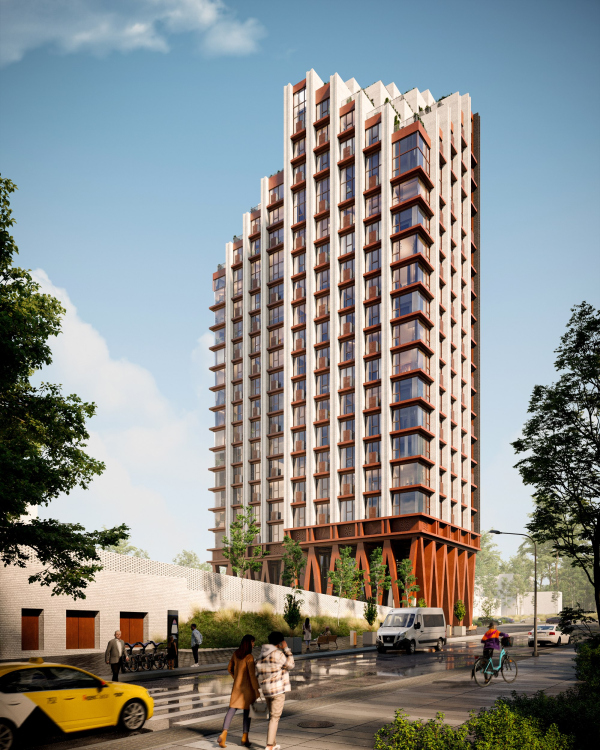 Residential Complex on Odesskaya Street in Nizhny NovgorodCopyright: © Ostozhenka ArchitectsThe entire façade grid is very voluminous – both the pilasters and the inter-floor moldings. The latter have a 60 cm overhang, allowing for floor-to-ceiling windows, and avoiding the infamous 120 cm high vertical pilaster, as the large horizontal overhang “cuts off” the fire. Mini-balconies are installed on the overhangs, which can be used for air conditioners or as a spot for a solitary smoker; they also complement the rhythm of the vertical pilasters with a regular checkerboard rhythm. Additionally, the relief of the façade consisting of glass and moldings, also provides its own aesthetic result. Nevertheless, brick serves as the background, and the main character here is weathered steel. The inter-floor moldings are made from it, as are the round columns inside, and the zigzag pattern of the external contour columns. It is also used for the technical floor belt above the columns, at the base of the residential floors. Residential Complex on Odesskaya Street in Nizhny NovgorodCopyright: © Ostozhenka ArchitectsRegarding the technical floor, the architects, partly in jest, call it “triglyph-metopal”: through the pauses of the “triglyphs”, whose axes coincide with the axes of the façade pilasters, “metopes” with images made from cut-out weathered steel are placed. The themes are borrowed from the wooden carvings of houses in the Nizhny Novgorod region, particularly from Gorodets, selected by the architects from Vladimir Goryachev’s book on Gorodets wooden carving. It is worth noting that since both cities are situated on the Volga River, they long preserved the relief carvings that were adopted from the ships of Peter the Great’s fleet in the early 18th century, as well as the motifs of this wooden carving, which are actually mythological, although they appear fairy-tale-like (yes, there is a difference). It is these motifs that the Ostozhenka Architects were choosing from: for example, the three-headed “Zmey Gorynych” (a three-headed dragon from Russian fairytales) or the bird Sirin, and mixed them with the ubiquitous solar sign rosettes found in wooden carvings. Residential Complex on Odesskaya Street in Nizhny Novgorod. A detail. Perforation of the frieze lined with weatherproof steelCopyright: © Ostozhenka ArchitectsWeathered steel is a beautiful and popular modern material; it is well-suited both for the 10-meter-high truss and for ornaments. However, I want to note another effect, somewhat paradoxical: the entire structure of the lower part of the house feels “wooden”. The reddish-brown color is characteristic not only of rust but also of wood, especially if it has been treated with linseed oil and has aged slightly but not yet turned gray – like the wood of a ship. Here, we recall that nearby are the Oka docks on one side and the wooden houses of the bourgeois development, still preserved from the late 19th – early 20th century, on the other. We also remember that wood pairs well with similar lattice-transparent structures. So, in a way, our house stands on a “wooden” pergola, only it has grown about three to four times larger. 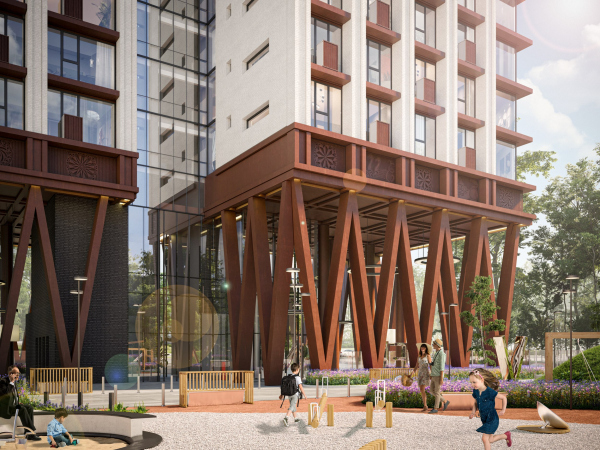 Residential Complex on Odesskaya Street in Nizhny NovgorodCopyright: © Ostozhenka Architects Residential Complex on Odesskaya Street in Nizhny NovgorodCopyright: © Ostozhenka ArchitectsThe idea of terraces over the river pairs well with the “pergola” – terraces, like courtyard loggias, are also one of the popular elements of modern housing. Not so long ago, 10 or 15 years back, it was thought that in “our climate” they were rather superfluous and unnecessary, but now the market has suddenly discovered the opposite – the terraces are the next big thing, and apartments with terraces, being more expensive, somehow sell faster... Here we can recall that Ostozhenka has been experimenting with terraces over water for quite some time: for example, there are terrace steps on the first-phase buildings of “River Park” in Moscow, which they designed back in 2013! Here, the terraces are at the corners of the white part of the towers, facing the river, descending stepwise from the 17th to the 15th floor, reaching the hypotenuse and cutting two external corners into “cubes”. 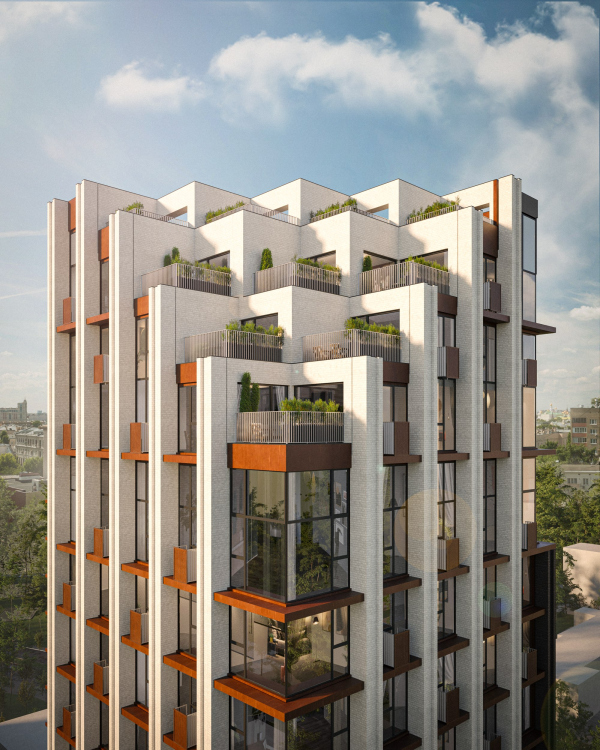 Residential Complex on Odesskaya Street in Nizhny NovgorodCopyright: © Ostozhenka Architects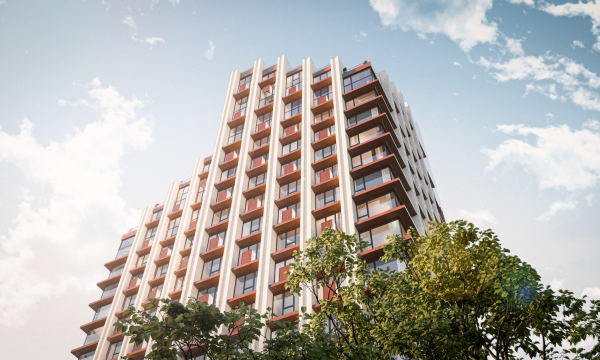 Residential Complex on Odesskaya Street in Nizhny NovgorodCopyright: © Ostozhenka ArchitectsAmong other things, the architects thought through the water drainage from the terraces, which was also quite a challenge: thus, the height of the 16th floor became greater than the others, namely, 4.5 meters, as a zigzag-shaped water drainage channel runs above some of the spaces. Future residents have the opportunity to design mezzanines in the higher part of their apartments. 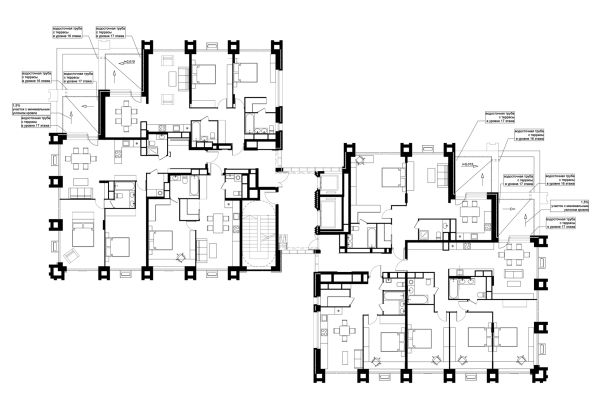 Plan of the 16 floor. Residential Complex on Odesskaya Street in Nizhny NovgorodCopyright: © Ostozhenka Architects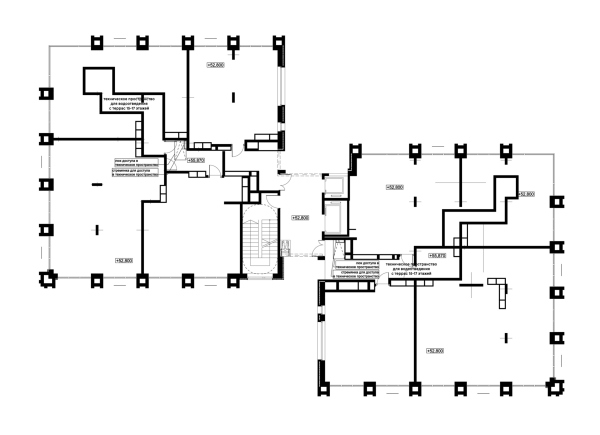 Plan of the 16 floor. Residential Complex on Odesskaya Street in Nizhny NovgorodCopyright: © Ostozhenka ArchitectsBoth landscaping and the design of the interiors of the public areas were done by the same architects, which is no small thing, as we already know how important the relationship between the exterior and the interior is in this case. The house is literally built on the idea, popular in modernist architecture and even its predecessor, Art Nouveau, of the connection and interpenetration of the exterior and the interior. As we have seen above, it is maximally open: to panoramas, to light, and even to the river air. Therefore, it was important for the architects to design – not just the interiors as a continuation of the facades – but the interiors of the public areas and the façade solutions as a whole, made from the same materials, “entering” inside or “exiting” from within, depending on how you look at it. In this sense, the key element is the interiors of the loggia underneath the buildings. They, we will remind you here, are ventilated, but since a barrier was still necessary, the architects proposed a glass one, made of triplex, about 2 meters high. It is designed at the base of the columns on the city side – as the most transparent solution. We saw a similar glass partition from Ostozhenka in a recently completed building on Kazakova Street. Partly, the glass will also protect from the Nizhny Novgorod river winds. 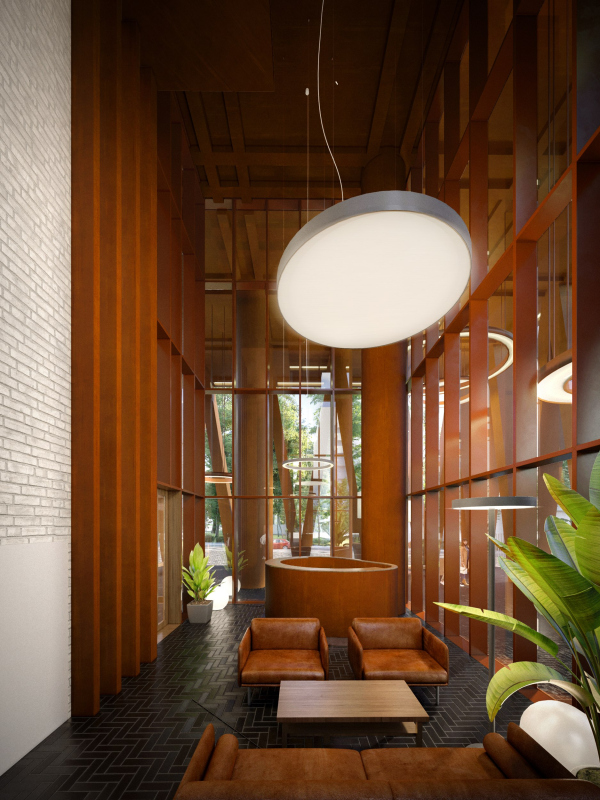 Residential Complex on Odesskaya Street in Nizhny Novgorod. The interiors of the public spacesCopyright: © Ostozhenka Architects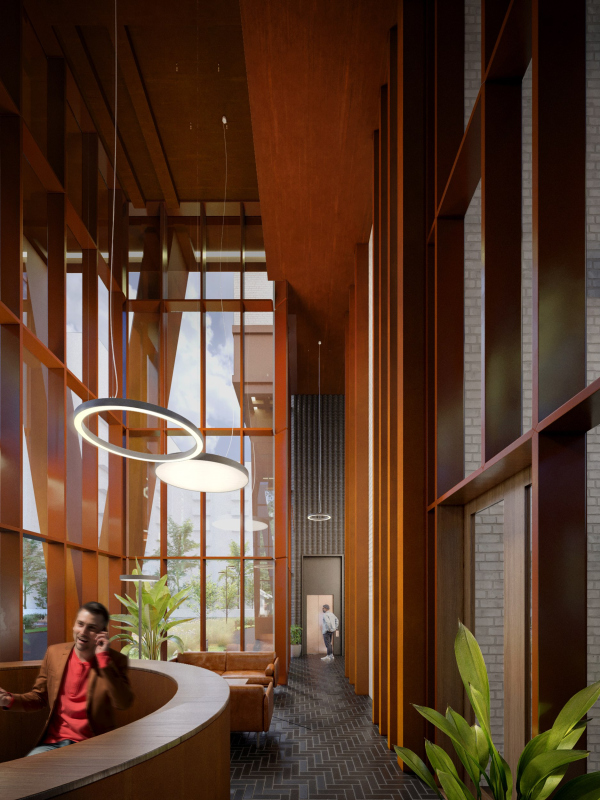 Residential Complex on Odesskaya Street in Nizhny Novgorod. The interiors of the public spacesCopyright: © Ostozhenka ArchitectsAll the other materials behave as if there is no glass at all: the ground beneath your feet is planned to be laid with dark Klinker brick both inside and outside – so that the pavement will be seamless. The columns of the frame, as well as the ceiling and flower pots, are clad in weathered steel; it is everywhere here. Residential Complex on Odesskaya Street in Nizhny Novgorod. The landscapingCopyright: © Ostozhenka ArchitectsResidential Complex on Odesskaya Street in Nizhny Novgorod. The landscapingCopyright: © Ostozhenka ArchitectsThe black-and-white composition dominated by rust-red surfaces is accented by natural plants in pots and wooden benches; in the lobby behind the glass, the weathered steel tones are echoed by the brown-beige upholstery of the leather furniture. The metal is also color-matched: matte-polished stainless steel for mailboxes and elevator doors, with a pink-gold hue that complements the weathered steel and a black hue that pairs with the black brick. Meanwhile, the brick, both black and white, boldly “entering” the interior from the facades, transforms into folded surfaces: they respond so well to oblique light and at the same time saturate the space with texture that any other decor, except perhaps live plants and city views outside the windows, is unnecessary. 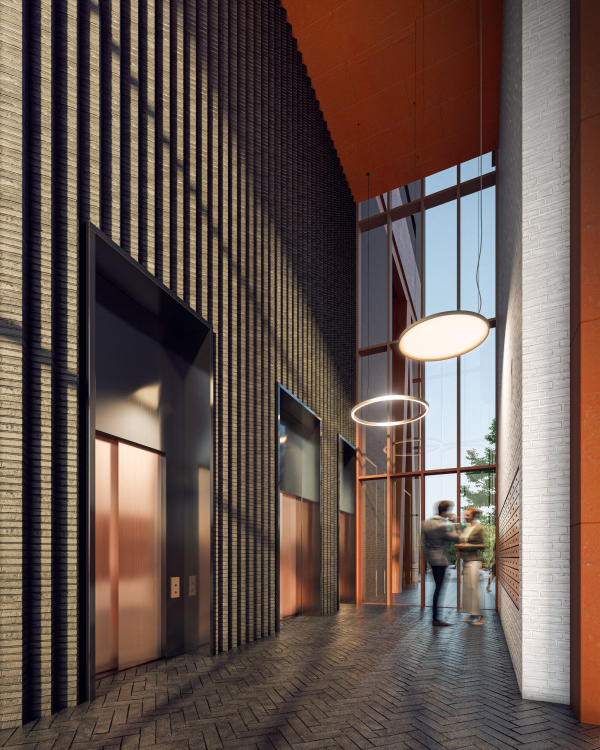 Folded brick surface in the lower tier of the “loggia” in front of the entrance. Residential Complex on Odesskaya Street in Nizhny Novgorod. The interiors of the public spacesCopyright: © Ostozhenka Architects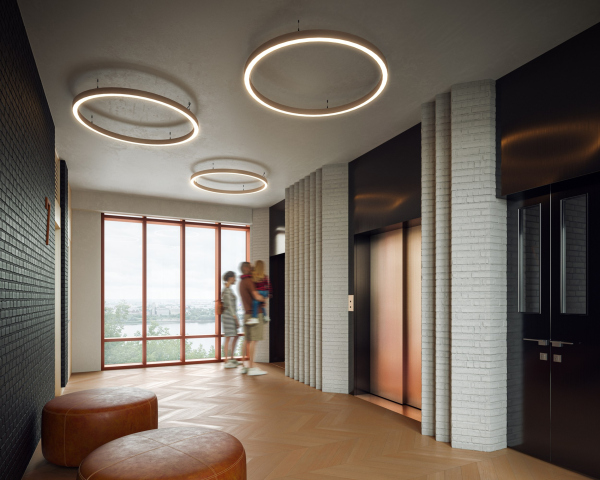 The folded brick surface in the elevator lobby – and a panoramic window there as well.Residential Complex on Odesskaya Street in Nizhny Novgorod. The interiors of the public spacesCopyright: © Ostozhenka ArchitectsInterestingly, the technique of angled bricks is quite popular nowadays, but folded “flutes”, achieved by simply rotating a brick block, became widespread and took hold back in the 1980s when executed in pink brick. However, this technique is usually used for facades. In this case, however, once again, we see the opposite: the brick enters the interior. The architects compare the toothed brick surfaces to the folds of drapes – I would even say that a comparison with the currently trendy pleated fabric might be more appropriate here. The corridors embrace the theme of contrast set on the facades: everything develops logically and, again, rhymes both outside and inside; one half is black, the other white, leaving no doubt about which facades are where. This might seem trivial and practically insignificant, but it’s fascinating when everything is so inherently logical. You could even explain it to your guests later on. Moreover, you can approach the glass end of the corridor, look, and confirm that yes, white is on the left, black on the right. 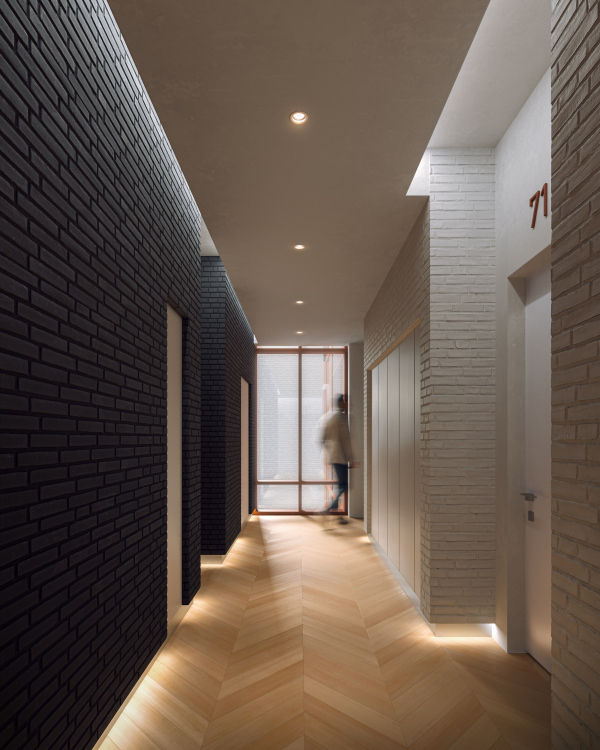 Residential Complex on Odesskaya Street in Nizhny Novgorod. The interiors of the public spacesCopyright: © Ostozhenka Architects Residential Complex on Odesskaya Street in Nizhny Novgorod. The interiors of the public spacesCopyright: © Ostozhenka ArchitectsThe lighting here, as on the facades, is hidden and shines reflected light, separating the top and bottom and highlighting the meeting points of the walls and floor with a ledge. First, it’s comfortable to have not only light wood-like ceramic granite underfoot but also plenty of light. Second, the interior seems to form before our eyes from volumes that slightly levitate and possess different properties. Despite the simplicity, we feel at the sensory level the work of this constructor set: the floor-wall-ceiling ensemble. This is not the plastic acanthuses of cheap cornices but their direct opposite. Instead of masking decor, we see the work of space and volume work to the fullest. The site of the building is rectangular, with one of its ends adjoining Odesskaya Street and stretching towards the river. However, the height difference here is not very significant compared to the 100-meter slope that begins just beyond the western border of this area. Nonetheless, there is a height difference of 3.5 meters. The buildings are closer to Odesskaya Street, but the entire rectangle is occupied by a single level of underground parking. On its roof, designed like a large terrace, there is a courtyard with a playground and workout area, landscaping with bushes and grasses, and even a small amphitheater – yet another place to watch sunsets and socialize. The amphitheater is integrated into the earthwork that conceals the technical room, and the entrance to the underground parking uses the natural height difference; it is also camouflaged and supported by a wall of white brick, which responds to the river-facing facades of the building and is laid in a lattice-like Brazilian pattern. In short, the building is quite interesting – at least in terms of the number of unconventional but pleasant solutions for future residents, because the direction of public spaces, which is so often talked about, is present here not in words but in deeds, significantly boosting the “degree of uniqueness”. Again, everyone around shouts about uniqueness, which is often absent, but here we see a whole number of solutions that are at least rare in contemporary residential construction. It is easy to see that many of these solutions can be traced back to the explorations of post-war modernism, which was much bolder in terms of volumetric and spatial construction than our contemporaries, who often fail to see the forest behind the trees. As a result, the project on Odesskaya Street has two key advantages: on the one hand, it is very clearly and logically structured, starting from the geometry of the plan, the structure of the interior, and ending with the motivation for this construction. On the other hand, there are no direct borrowings in it: experiments rooted somewhere in the seventies receive quite modern development: if you have “legs”, then they are 10 meters tall, made of weathered steel and triplex; if you have brick, it is glazed; if you have panoramas, they are open in all directions. For some reason, I cannot get rid of the feeling that such freedom is only possible in Nizhny Novgorod. The project has been approved by the Nizhny Novgorod City Council, received positive expert reviews, and has obtained a building permit, with construction already underway. 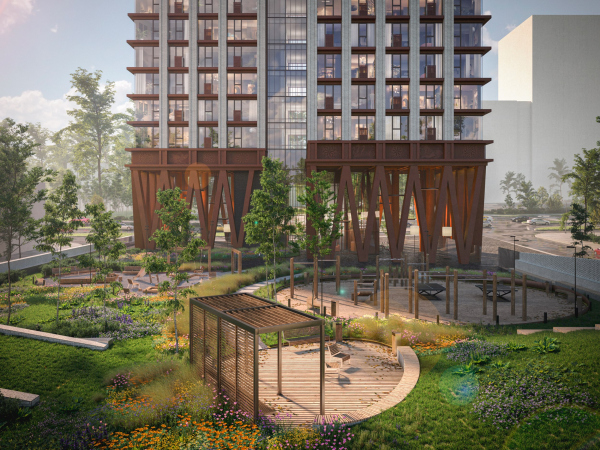 Residential Complex on Odesskaya Street in Nizhny Novgorod. The landscapingCopyright: © Ostozhenka Architects Residential Complex on Odesskaya Street in Nizhny Novgorod. The landscapingCopyright: © Ostozhenka Architects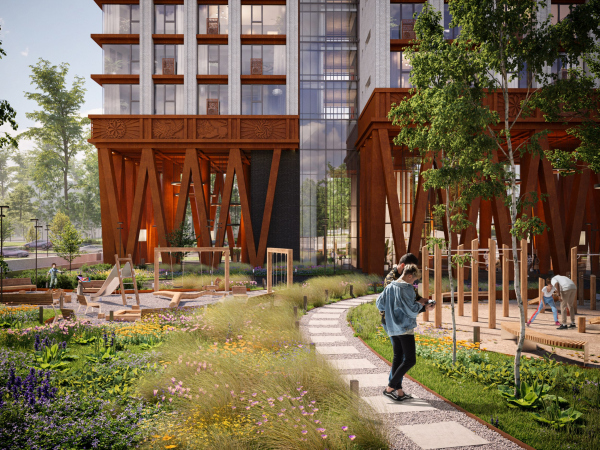 Residential Complex on Odesskaya Street in Nizhny Novgorod. The landscapingCopyright: © Ostozhenka Architects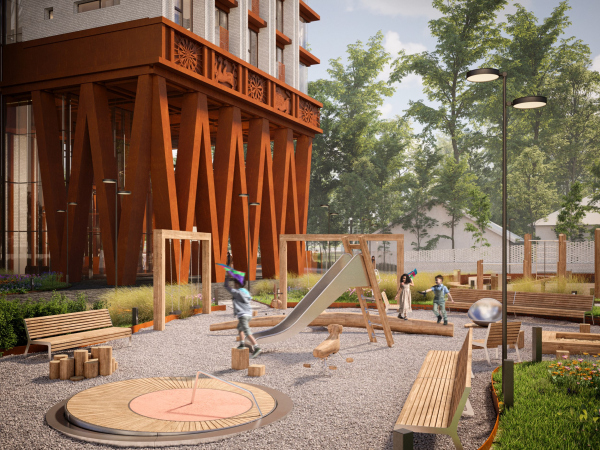 Residential Complex on Odesskaya Street in Nizhny Novgorod. The landscapingCopyright: © Ostozhenka Architects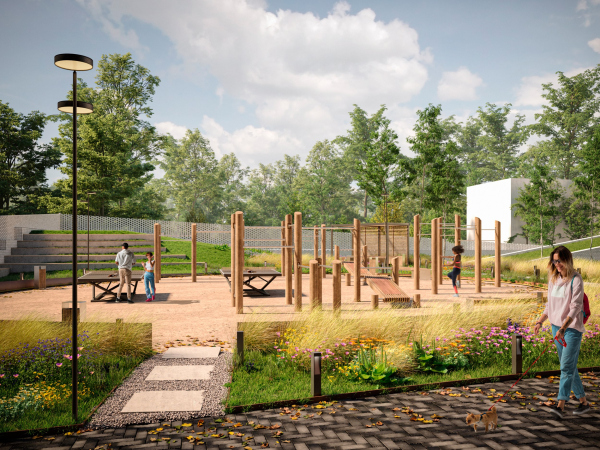 Residential Complex on Odesskaya Street in Nizhny Novgorod. The landscapingCopyright: © Ostozhenka Architects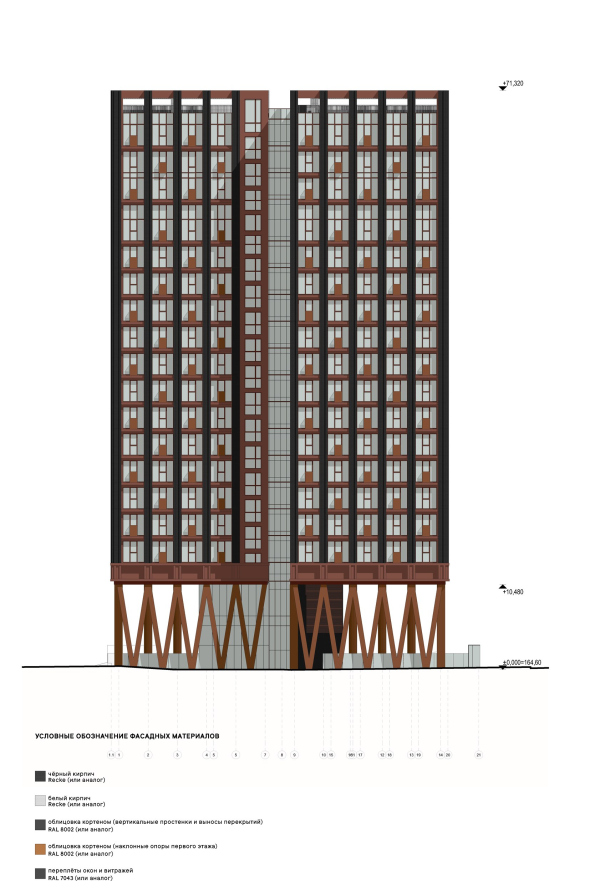 Residential Complex on Odesskaya Street in Nizhny NovgorodCopyright: © Ostozhenka Architects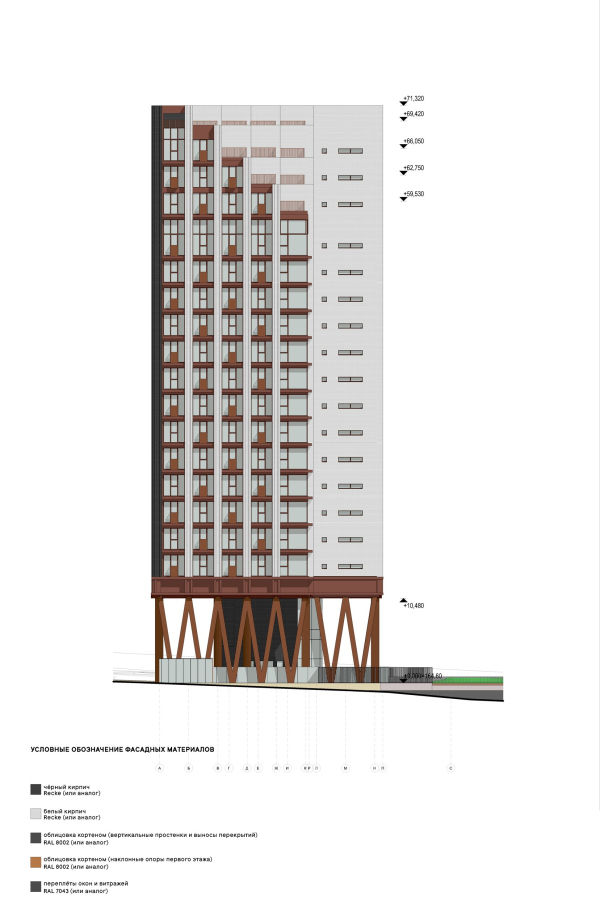 Residential Complex on Odesskaya Street in Nizhny NovgorodCopyright: © Ostozhenka Architects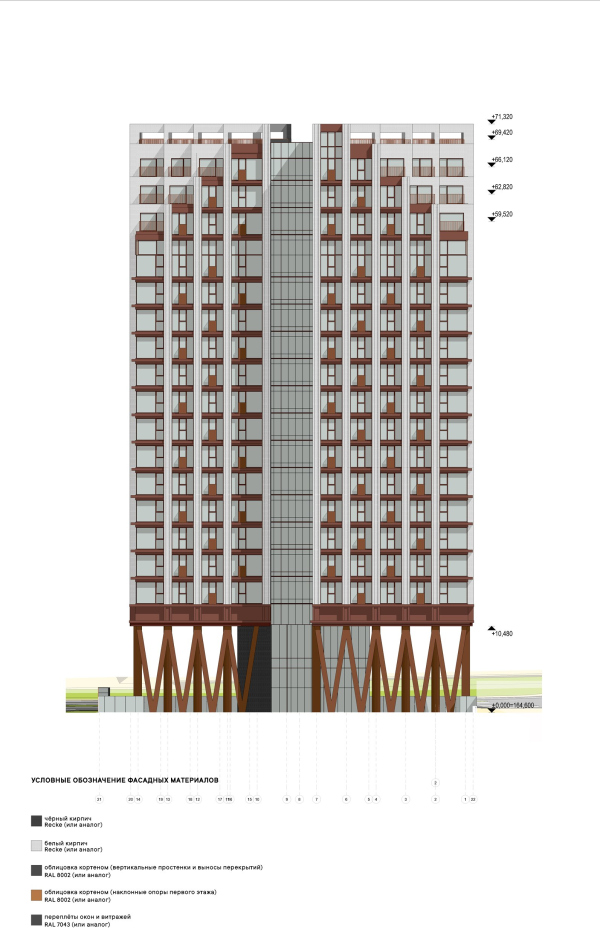 Residential Complex on Odesskaya Street in Nizhny NovgorodCopyright: © Ostozhenka Architects Residential Complex on Odesskaya Street in Nizhny NovgorodCopyright: © Ostozhenka Architects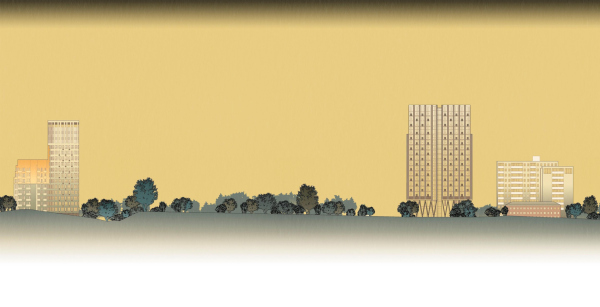 Residential Complex on Odesskaya Street in Nizhny NovgorodCopyright: © Ostozhenka Architects |
|
